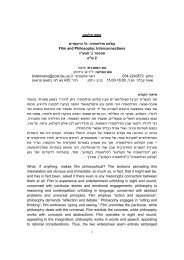The Iconography of the Temple in Northern Renaissance Art
The Iconography of the Temple in Northern Renaissance Art
The Iconography of the Temple in Northern Renaissance Art
Create successful ePaper yourself
Turn your PDF publications into a flip-book with our unique Google optimized e-Paper software.
Judaea and Synagoga and Damnation had long been an iconographical tradition.<br />
Synagoga and <strong>the</strong> Jews are damned for <strong>the</strong>ir unbelief or <strong>the</strong>ir betrayal <strong>of</strong><br />
God. One <strong>of</strong> <strong>the</strong> earliest sources for this motif is a Crucifixion <strong>in</strong> <strong>the</strong> famous<br />
12th century manuscript, <strong>the</strong> Liber Floridus by Lambert <strong>of</strong> St.-Omer (London,<br />
B.L. Add. Ms. 50003, fol. 34 r ). On Christ's left is Synagoga; her crown is fallen<br />
and Christ is push<strong>in</strong>g her <strong>in</strong>to Hell's mouth (Leviathan) while bestow<strong>in</strong>g<br />
bless<strong>in</strong>gs on Ecclesia. 66 In 13th and 14th century Bibles Moralisées Jews frequently<br />
figure as damned and pushed <strong>in</strong>to <strong>the</strong> mouth <strong>of</strong> Hell; very <strong>of</strong>ten, <strong>the</strong>y are<br />
symbolically associated with Synagoga. 67 In a 13th century Bible Moralisée<br />
(Oxford, Bodleian 207b, fol. 119v), <strong>the</strong> moralisation medallion for Samson's<br />
Death, on <strong>the</strong> left side <strong>of</strong> <strong>the</strong> cross, shows a group <strong>of</strong> Jews fallen <strong>in</strong>to Leviathan's<br />
mouth. This group is contrasted with a group <strong>of</strong> clerics. <strong>The</strong> moralization text<br />
states that like <strong>the</strong> dy<strong>in</strong>g Samson who had condemned <strong>the</strong> Philist<strong>in</strong>es toge<strong>the</strong>r<br />
with himself, so Christ, when he died on <strong>the</strong> Cross, had condemned <strong>the</strong> Jews<br />
to destruction. In ano<strong>the</strong>r contemporary French Bible Moralisée (Vienna, O.N.B.<br />
cod. 1179, fol. 132r), a group <strong>of</strong> Jews is led by a devil to hell below <strong>the</strong> Cross. A<br />
woman beh<strong>in</strong>d <strong>the</strong>m is identified as S<strong>in</strong>agoga Musi (Synagogue <strong>of</strong> Moses). 68<br />
In 15th century sources, 69 ma<strong>in</strong>ly <strong>in</strong> Liv<strong>in</strong>g Cross images, Synagoga is<br />
associated with <strong>the</strong> Fall <strong>of</strong> Man (Eve) and damnation. She rides an ass, hold<strong>in</strong>g<br />
a goat (sometimes black). Below her we see <strong>the</strong> Bad Tree (Arbor Mala),<br />
symbolically associated with her. Eve, hold<strong>in</strong>g a skull, stands beside <strong>the</strong> Bad<br />
Tree. Beneath Synagoga and Eve, Hell gapes. Synagoga <strong>in</strong> <strong>the</strong> Liv<strong>in</strong>g Cross is<br />
opposed <strong>in</strong> moral symmetry to Ecclesia rid<strong>in</strong>g <strong>the</strong> Evangelic Beast. Below her<br />
we see <strong>the</strong> Good Tree and <strong>the</strong> door <strong>of</strong> Paradise open<strong>in</strong>g to <strong>the</strong> Just. 70<br />
<strong>The</strong> red colour <strong>of</strong> <strong>the</strong> <strong>Temple</strong> <strong>in</strong> Quarton's Coronation <strong>of</strong> <strong>the</strong> Virg<strong>in</strong> should<br />
also be considered on a symbolic level. Red, like yellow, was associated with<br />
evil and Satan, 71 and demonstrates <strong>the</strong> association between <strong>the</strong> red <strong>Temple</strong><br />
and <strong>the</strong> personification <strong>of</strong> Synagoga.<br />
Synagoga sometimes wears a yellow dress <strong>in</strong> some medieval and late<br />
medieval dramas, as well as visual sources. 72 Occasionally <strong>the</strong> yellow robe is<br />
replaced by a black one which symbolises Synagoga turn<strong>in</strong>g away from God<br />
and tempted by Satan. 73 In a Passion played <strong>in</strong> Avignon <strong>in</strong> December 1385,<br />
Synagoga wore a black dress and held a red banner. 74<br />
In a late 14th century manuscript, <strong>the</strong> famous Bible Moralisée from Philippe<br />
le Hardi's Library (Paris, B.N. fr. 166), Synagoga is several times depicted <strong>in</strong> a<br />
brown robe, 75 and her hair is reddish. 76 This red hair is not accidental. It would<br />
have <strong>the</strong> same symbolical mean<strong>in</strong>g as that associated with <strong>the</strong> dress or banner,<br />
which l<strong>in</strong>k Synagoga to <strong>the</strong> forces <strong>of</strong> evil, similar to Ca<strong>in</strong>'s or Judas' hair or that<br />
<strong>of</strong> <strong>the</strong> executioners and betrayers <strong>of</strong> Christ. 77<br />
162
















